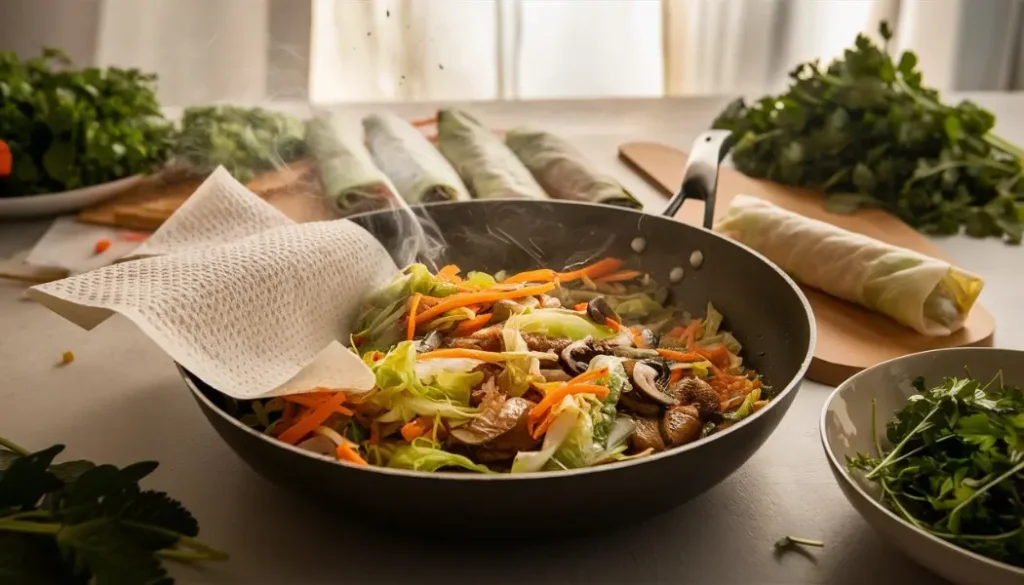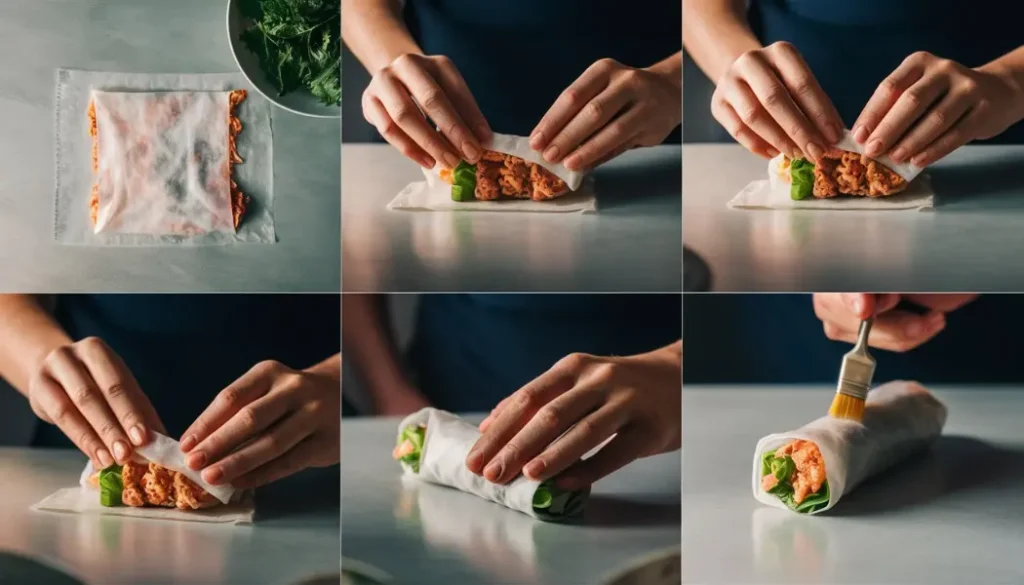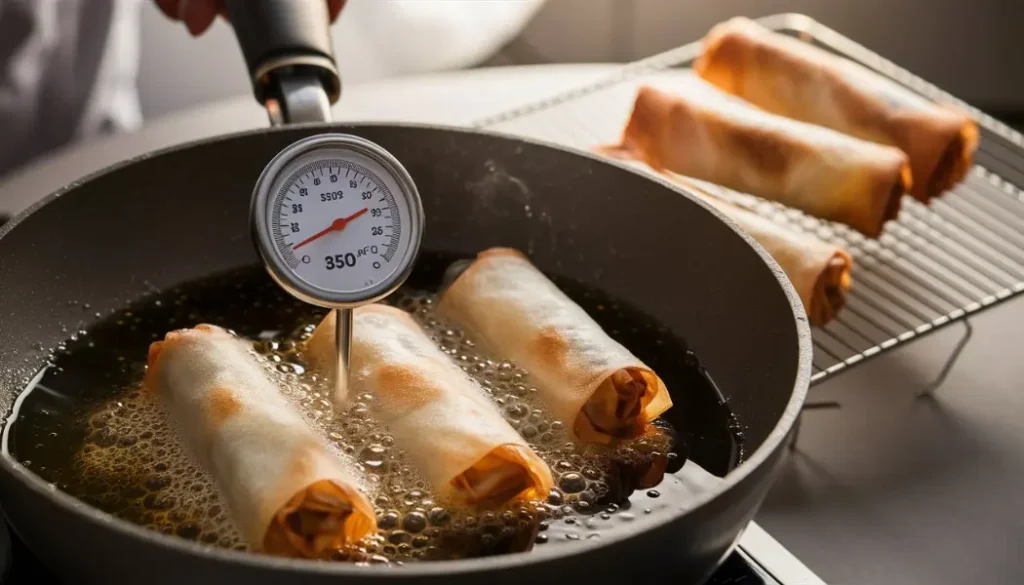The Perfect Crunchy Spring Roll
There’s nothing quite as satisfying as biting into a perfectly crispy spring roll. But knowing how to prevent spring rolls from getting soggy can be tricky. Whether you’re making them at home or ordering from your favorite spot, soggy spring rolls can quickly ruin the experience. That’s why we’re here to help you avoid the most common mistakes and keep your rolls crispy and delicious every time!
If you’ve ever wondered how to prevent spring rolls from getting soggy, you’re not alone. This common issue can arise at any stage of the process—from filling to wrapping, to cooking, and even storage. The good news is, with a few simple tweaks and some smart cooking techniques, you can prevent this from happening.
In this article, we’ll dive deep into what causes soggy spring rolls and, more importantly, how to avoid it. By the end, you’ll have all the tips and tricks you need to ensure that every spring roll you make comes out crispy, crunchy, and absolutely delicious.
Common Causes of Soggy Spring Rolls
Before we get into solutions, it’s important to understand the root of the problem. What exactly causes spring rolls to become soggy? Understanding these causes will help you avoid them and guarantee that crunch we all crave.
- Excess Moisture in the Filling: One of the most common reasons for soggy spring rolls is moisture inside the filling. Ingredients like vegetables, meats, or seafood naturally release water during cooking. If this moisture isn’t properly dealt with, it seeps into the wrapper, leaving your roll damp and unappetizing.
- Incorrect Wrapping Technique: Believe it or not, how you wrap your spring rolls plays a significant role in their texture. If the roll isn’t wrapped tightly enough, air can get trapped inside. When this happens, steam can build up during frying or baking, making the wrapper wet instead of crisp.
- Cooking Temperature Issues: The temperature of your oil or oven is crucial when it comes to achieving the perfect spring roll. If the oil is too hot, the outside of the roll will cook too quickly while the inside remains raw, leading to uneven texture. On the other hand, if the oil is too cold, the rolls will soak up excess oil, resulting in a greasy, soggy roll. The same principle applies to baking—temperature control is key.
- Improper Storage: Even if you’ve nailed the filling and cooking process, storing spring rolls improperly can undo all your hard work. Leaving them in a sealed container without airflow can trap moisture, making them soggy even after you’ve fried or baked them to perfection.
Dry Your Fillings Properly

Now that we know one of the main culprits of soggy spring rolls is moisture in the filling, let’s focus on fixing that problem. Whether you’re using vegetables, meat, or seafood as your filling, removing excess moisture is key to keeping your spring rolls crisp.
Why This Works: Ingredients like cabbage, carrots, mushrooms, and leafy greens tend to release a lot of water when cooked. Meat fillings like ground pork, chicken, or shrimp can also release juices during cooking. If you wrap your spring rolls with these watery fillings, the moisture has nowhere to go but into the wrapper, making it soggy.
How to Do It:
- Pre-cook Your Filling: One of the simplest ways to remove excess moisture is to cook your filling before wrapping it. Lightly sauté your vegetables or cook your meat fillings until most of the water has evaporated. For vegetables like cabbage, sprinkle a little salt on them and let them sit for a few minutes before cooking. This will draw out excess moisture.
- Blot with Paper Towels: After cooking your filling, spread it out on paper towels and gently blot away any remaining moisture. This is especially helpful for fillings with high water content, like mushrooms and leafy greens.
- Drain Meat Juices: If you’re using a meat filling, make sure to drain any juices after cooking. Let the meat sit for a few minutes so any extra liquid can drain away.
Another trick is to avoid adding too much sauce to your filling, as sauces can contribute to the sogginess. Instead, serve sauces on the side for dipping. By ensuring your filling is dry, you’re setting yourself up for crispy success.
Use the Right Wrapping Technique

You might not think that wrapping spring rolls takes much skill, but the truth is, your technique plays a huge role in preventing sogginess. A tightly wrapped spring roll not only looks better but also helps to prevent air pockets that can lead to soggy results.
Why This Works: When the filling is wrapped tightly, it reduces the chance of air and steam building up inside the roll. This allows the wrapper to cook evenly and remain crispy, instead of becoming damp and limp from excess moisture.
How to Do It:
- Place the Filling Correctly: Start by placing your filling in the center of the wrapper. Be sure not to overfill—less is more when it comes to ensuring an even wrap. Overfilling makes it harder to roll tightly and can cause the wrapper to tear.
- Tuck and Roll: Begin by folding the sides of the wrapper over the filling, then fold the bottom of the wrapper up over the filling. Tuck it tightly as you roll the spring roll away from you. This method keeps everything snug and in place, reducing air pockets.
- Seal It Properly: To keep your roll from unraveling while cooking, seal the edge of the wrapper with a dab of water or a beaten egg. This creates a tight seal that prevents oil from seeping in during frying.
Pro Tip: The type of wrapper you use matters too! Rice paper wrappers are great for fresh rolls, but if you’re frying or baking, go for thin wheat wrappers. These crisp up beautifully in the oil or oven.
Control the Temperature When Cooking
Even with perfectly dry fillings and expert wrapping, cooking your spring rolls at the wrong temperature can ruin their texture. Let’s talk about how to get it just right.
Why This Works: The right cooking temperature ensures that the spring roll wrapper cooks evenly without absorbing too much oil. If your oil is too cold, your rolls will turn out greasy and limp. Too hot, and the outside will burn before the inside has a chance to cook through.
Frying Temperature: For frying, aim for an oil temperature of around 350°F to 375°F (175°C to 190°C). Use a cooking thermometer to check the temperature of the oil before you begin. If you don’t have one, a good trick is to drop a small piece of bread into the oil. If it sizzles and turns golden in about 30 seconds, your oil is ready.
Baking Option: If you prefer baking, preheat your oven to 400°F (200°C). Place the spring rolls on a wire rack on top of a baking sheet to allow air to circulate and crisp up the rolls on all sides.
By paying attention to the cooking temperature, you’ll get that perfectly crispy, golden spring roll every time.
Control the Temperature to Prevent Soggy Spring Rolls

Even with perfectly dry fillings and expert wrapping, cooking at the wrong temperature can lead to soggy spring rolls. Getting the temperature just right is crucial to achieving that crispy exterior. One of the most common mistakes is frying or baking spring rolls at the wrong temperature, which directly impacts their texture.
Why It Matters: Cooking at the correct temperature ensures that the spring roll wrapper crisps up without soaking up too much oil or moisture. If your oil is too cold, the spring rolls will absorb excess oil, making them greasy and soggy. If the oil is too hot, the outside will burn while the inside remains undercooked, resulting in uneven texture and disappointment when you take that first bite.
Frying the Right Way: For perfect results, aim for an oil temperature of 350°F to 375°F (175°C to 190°C). If the oil is below 350°F, the spring rolls will soak up oil, making them soggy instead of crispy. You can check the oil temperature using a kitchen thermometer or a simple trick: drop a small piece of bread into the oil. If it sizzles and turns golden within 30 seconds, you’re ready to fry.
Baking Option: Prefer a healthier alternative? You can still get crispy spring rolls without frying. Preheat your oven to 400°F (200°C). Place your rolls on a wire rack set on top of a baking sheet. This allows the heat to circulate around the spring rolls evenly, ensuring they crisp up on all sides.
Air Fryer Option: Air frying is another great way to cook spring rolls while maintaining crispness. Set your air fryer to 375°F and cook the spring rolls for 8-10 minutes, flipping them halfway through. The air fryer helps keep spring rolls crunchy without the need for oil.
Understanding temperature control is key when learning how to prevent spring rolls from getting soggy. Whether frying, baking, or air frying, getting the temperature right is crucial for that perfect crunch.
How to Drain and Rest Spring Rolls After Frying to Prevent Sogginess
Once your spring rolls are fried or baked to golden perfection, the way you handle them afterward can make or break their texture. If you place them directly on a plate or paper towels, the trapped steam can make the spring rolls soggy. Let’s talk about how to properly drain and rest them to maintain crispiness.
Why It Matters: The post-cooking process is just as important as cooking itself. Draining your spring rolls properly after frying prevents them from absorbing any excess oil. Additionally, resting them correctly allows air to circulate, helping to keep the wrapper crispy.
The Best Way to Drain Spring Rolls: Instead of using paper towels, which can trap moisture underneath, place your freshly cooked spring rolls on a wire rack. This allows any excess oil to drip off and lets air circulate around the rolls, preventing moisture from building up.
Resting in the Oven: If you’re preparing a large batch or want to keep your spring rolls warm for a little longer, place them in the oven at a low temperature (around 200°F/90°C). This will keep the rolls warm without allowing them to become soggy. The oven’s dry heat ensures they maintain their crispiness until serving time.
By letting your spring rolls rest properly, you’ll extend their crispiness and avoid the dreaded soggy texture. Draining and resting are simple yet effective ways of learning how to prevent spring rolls from getting soggy.
How to Store Spring Rolls to Prevent Them from Getting Soggy Later
Even after preparing the perfect spring rolls, improper storage can turn your crunchy creation into a soggy mess. Whether you’re storing leftovers or making spring rolls ahead of time, it’s important to know how to store them correctly to maintain that delicious crispiness.
Why It Matters: Improper storage traps moisture, leading to soggy rolls. The key is to allow air circulation and prevent condensation from softening the wrapper.
Short-Term Storage Tips: If you’re planning to serve your spring rolls within a few hours, leave them at room temperature. Place them on a wire rack and cover lightly with a paper towel or breathable cloth to allow air circulation. Avoid sealing them in an airtight container, as this can create steam and moisture buildup, making the rolls soggy.
Long-Term Storage Tips: Need to store spring rolls overnight or for longer? The best way to do this is by freezing them. Place the cooked, cooled spring rolls in a single layer on a baking sheet and freeze for an hour. Once they’re frozen, transfer them to an airtight container or zip-lock bag. This method ensures they don’t stick together, and freezing locks in the crispiness.
Reheating to Maintain Crispiness: When reheating frozen spring rolls, don’t use a microwave—this will make them soft and soggy. Instead, reheat them in an oven at 350°F (175°C) for about 10 minutes or use an air fryer to bring back their crisp texture.
Knowing how to store and reheat spring rolls is crucial for those learning how to prevent spring rolls from getting soggy, especially when planning ahead for a party or saving leftovers.
Bonus Tips to Prevent Spring Rolls from Getting Soggy
Now that you have the main techniques down, here are a few bonus tips to ensure your spring rolls come out perfectly crispy every time.
- Light Dusting of Cornstarch: Before frying, lightly dust the spring rolls with cornstarch. This helps create an extra barrier to prevent moisture from the filling affecting the wrapper.
- Serve Immediately: Spring rolls are best served immediately after frying. The longer they sit, the more moisture they’ll absorb. If possible, time your cooking so that they’re fresh when served.
- Choose the Right Wrapper: For fried spring rolls, thin wheat wrappers crisp up better than thicker ones or rice paper wrappers. Pay attention to the type of wrapper you’re using to match the cooking method.
These small details can make a big difference and are essential when understanding how to prevent spring rolls from getting soggy.
Conclusion: Mastering the Crunch in Spring Rolls
Achieving the perfect crispy spring roll is easier than you think once you understand the process. By drying your fillings, mastering the wrapping technique, controlling your cooking temperature, and handling them properly after cooking, you’ll be able to serve up spring rolls that are crispy on the outside and flavorful on the inside—every time.
Remember, when learning how to prevent spring rolls from getting soggy, every step matters. Whether you’re frying or baking, or storing and reheating, each technique plays a role in preserving that much-desired crunch. So, next time you’re in the kitchen making spring rolls, follow these tips, and say goodbye to sogginess for good!
